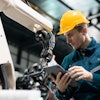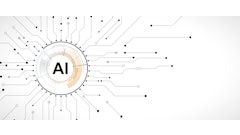
In the fast-paced world of service delivery and fulfilment, the constant balancing act lies in meeting ever-fluctuating customer demands and unpredictable service needs, while managing an appropriately staffed mobile workforce. This is further exacerbated by the huge skills shortage in field service with The Service Council research indicating 70% of organizations will be challenged by a retiring workforce over the next 5-10 years.
One answer lies in a new breed of technologies designed to intelligently manage the ad hoc availability of a growing and readily available pool of temporary workers—to ensure good service delivery is always-on. AI-powered planning and scheduling is just one of the new technology applications that are enabling service companies to revolutionize their delivery, optimize resources, and enhance customer satisfaction.
Service organizations face a balancing act to meet pressing and changing customer demands alongside a fluctuating workforce—putting increasing pressure across the supply chain. The nature of service work is very people-centric, with skilled technicians providing a service directly to end customers, but the demand for the work is elastic and can rise and fall without warning. Whether it's facilities management, field service, or a deeper dive into specialized repairs, the ability to quickly and efficiently deploy personnel is critical.
Take an emergency windscreen repair or a boiler issue, for example. These are not planned events. In fact, for most customers, they are a distress purchase that needs resolving as quickly as possible to keep them moving, or safe and comfortable inside their homes. The onus is on the service provider to react quickly and to fix issues the first time to keep customers happy and profit margins high.
Temporary workers pick up the slack
As a result, in service-based industries, many organizations rely on temporary workers, sometimes referred to as non-permanent or contingent employees. Their number is growing. Latest figures from the U.S. Bureau of Labor Statistics estimates that in 4.3% of workers – nearly 7 million people – hold temporary jobs.
These workers are often hired on a project-by-project or short-term basis to fill specific needs, such as seasonal demand, specialized skill requirements or to provide cover in more remote geographies. They can include freelancers, independent contractors, and agency workers, and are often brought in to supplement the core workforce.
Gig economy suits workers and employers
For some workers, flexibility is the name of the game. They fit in work around their lifestyle and daily routines to give them more control over their work schedules and projects. This is increasingly being referred to as the rise of the “gig economy.”
The World Economic Forum reports that: “Independence and flexibility were cited as the main aspect for people working in the gig economy…. For students who want to earn an income while studying, or primary carers who want to fit work around school or daycare hours, companies can offer flexible working patterns.”
This represents an untapped workforce for service organizations that is only expected to increase in today’s digital and flexible working world. These temporary workers have emerged as a vital solution to provide service organizations with the flexibility to scale operations up or down as needed. However, to truly maximize the benefits of a temporary workforce, they must be seamlessly managed to optimize and not degrade service delivery, and the technology is here to do just this.
Turning the workforce tap on and off in minutes requires a one-workforce view
Seasonality often plays a huge role in leveraging a temporary workforce. Incorporating a doubling of headcount can wreak havoc on existing workforce scheduling tools, especially if they’re being managed manually. Building a separate service model to accommodate them is expensive and ineffective—they need to be integrated into existing models.
Take the example of a company in Canada that manages heating services to residential homes that must scale up from 700 full-time employees to 1,600 in the winter months. It's that volatility that is absorbed by onboarding a temporary workforce, but they need to become part of the existing model and be incorporated into workflows and scheduling as soon as possible. Service organizations need a system that maintains a singular, holistic view of the operation with an integrated service model—regardless of worker status.
Augmented reality-enabled remote assistance to extend reach and empower inexperienced workers
But technology-assisted service is not always about taking workers to the customer doorstep. It can also be about delivering them expertise on-demand to help them execute their in-field tasks. This is especially important when dealing with an enlarged temporary workforce that may not all have the experience of longer-term senior technicians.
Augmented reality-enabled remote assistance technologies via tablet and smartphone are transforming how service is delivered. These tools enable experts to provide one-to-many virtual guidance, helping to perform remote diagnostics and troubleshoot issues without being physically present. For temporary workers, remote assistance can be a game-changer. An inexperienced temporary technician can connect with a remote expert who can visually guide them through a repair, effectively standing over their shoulder virtually. This not only enhances the temporary worker's capabilities but also reduces the need for multiple on-site visits, saving time and money. Remote assistance can even expand the geographic reach of service organizations, enabling a smaller pool of workers to support a larger area.
AI-powered planning and scheduling for an intelligently organized temporary workforce
Effective planning and scheduling are key to being able to intelligently leverage temporary workers, and it starts with taking a strategic view of the operation and its workforce. That is where Artificial Intelligence, with its huge bandwidth to deal with and analyze large amounts of data, is a crucial part of this process. Take for example a what-if scenario explorer, which enables companies to model scenarios such as winning a new contract, expanding into an additional geography, or being challenged to up their service levels, all in an effort to determine the impact on the workforce—do I have the right number of resources in the right location with the right skills?
Thereafter, AI and machine learning can dynamically optimize workforce scheduling, and dispatch. By intelligently managing resources and optimizing routes based on various factors such as skills, location, and SLA, service organizations are able to improve efficiency, reduce costs, and enhance customer satisfaction
The employee ripple effect is clear. Efficient scheduling leads to a better temporary worker experience. When their time is valued and well-managed, temporary workers are more likely to be satisfied and engaged, contributing to higher retention rates. At the same time, this then potentially provides an opportunity to tap into those individuals who up to this point may have felt excluded from the wider workforce or where their need for flexibility was seen as an obstacle.
Agile, intelligent, and sustainable service delivery
Service organizations must be able to exploit the growing and valuable source of temporary workers and the gig economy to quickly scale operations on demand as requirements shift. This new breed of AI-enabled planning and scheduling optimization tools will ensure they can deliver the necessary skills at the point of need and exploit augmented reality-enabled remote assistance technologies to empower less experienced staff. It’s a win for everyone, including AI.













![Pros To Know 2026 [color]](https://img.sdcexec.com/mindful/acbm/workspaces/default/uploads/2025/08/prostoknow-2026-color.mduFvhpgMk.png?ar=16%3A9&auto=format%2Ccompress&bg=fff&fill-color=fff&fit=fill&h=135&q=70&w=240)



